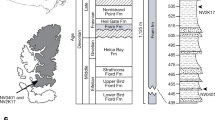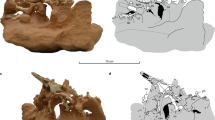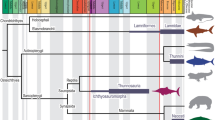Abstract
THE origin of tetrapods is generally associated with the emergence of terrestrial vertebrate life. Anatomical features unique to tetrapods are usually considered to be adaptations to the terrestrial environment. Here we report the discovery of a fish-like branchial skeleton in Acanthostega gunnari, from the Upper Devonian of East Greenland, one of the earliest tetrapods known. It shows a proximally expanded ceratohyal and large, ventrally grooved ceratobranchials. Such grooves are found in the ceratobranchials of modern fishes, and house the afferent branchial aortic arches. The shoulder girdle bears a postbranchial lamina along its anterior margin. In fishes this supports the posterior wall of the opercular chamber. Acanthostega seems to have retained fish-like internal gills and an open opercular chamber for use in aquatic respiration, implying that the earliest tetrapods were not fully terrestrial. The discovery provides information on the sequence of acquisition of tetrapod characters, and supports previous suggestions that such characters as legs with digits1 evolved first for use in water.
This is a preview of subscription content, access via your institution
Access options
Subscribe to this journal
Receive 51 print issues and online access
$199.00 per year
only $3.90 per issue
Buy this article
- Purchase on Springer Link
- Instant access to full article PDF
Prices may be subject to local taxes which are calculated during checkout
Similar content being viewed by others
References
Coates, M. I. & Clack, J. A. Nature 347, 66–69 (1990).
Bendix-Almgreen, S. E., Clack, J. A. & Olsen, H. Rapp. Gronlands geol. Unders. 140, 95–102 (1988).
Clack, J. A. Nature 342, 425–430 (1989).
Miles, R. S. Zool. J. Linn. Soc. 61, 1–328 (1977).
Jarvik, E. Basic Structure and Evolution of Vertebrates Vol. I (Academic, London, 1980).
Milner, A. R. In The Phylogeny and Classification of Tetrapods. Vol. I: Amphibia, Reptiles, Birds (ed. Benton, M. J.) 59–102 (Clarendon, Oxford, 1988).
Sushkin, P. P. Trav. Inst. pal. Acad. Sci. USSR 5, 43–91 (1936).
Bystrow, A. P. Acta zool. 19, 209–295 (1938).
Grande, L. & Bemis, W. E. Memoir 1 J. vert. Paleont. 11 (1991).
Campbell, K. S. W. & Barwick, R. E. Geol. Mag. 125, 207–227 (1989).
Allis, E. P. J. Anat. 56, 189–294 (1922).
Lebedev, O. A. Dokl. Akad. Nauk. SSSR 278, 1407–1473 (1984).
Duellman, W. E. & Trueb, L. Biology of Amphibians (McGraw-Hill, New York, 1986).
Carroll, R. L. Vertebrate Palaeontology and Evolution (Freeman, New York, 1988).
Edwards, J. L. Am. Zool. 29, 235–254 (1989).
Author information
Authors and Affiliations
Rights and permissions
About this article
Cite this article
Coates, M., Clack, J. Fish-like gills and breathing in the earliest known tetrapod. Nature 352, 234–236 (1991). https://doi.org/10.1038/352234a0
Received:
Accepted:
Issue Date:
DOI: https://doi.org/10.1038/352234a0
This article is cited by
-
Comparative iTRAQ proteomics revealed proteins associated with lobed fin regeneration in Bichirs
Proteome Science (2019)
-
Morphology of the earliest reconstructable tetrapod Parmastega aelidae
Nature (2019)
-
A Devonian tetrapod-like fish reveals substantial parallelism in stem tetrapod evolution
Nature Ecology & Evolution (2017)
-
Five palaeobiological laws needed to understand the evolution of the living biota
Nature Ecology & Evolution (2017)
-
Where are we in understanding salamander locomotion: biological and robotic perspectives on kinematics
Biological Cybernetics (2013)
Comments
By submitting a comment you agree to abide by our Terms and Community Guidelines. If you find something abusive or that does not comply with our terms or guidelines please flag it as inappropriate.



